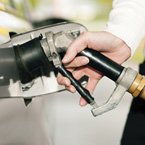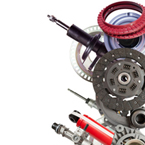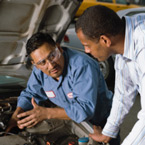 Cabin air filtration is quite easily the most easily forgotten auto maintenance item in passenger cars. Since their introduction in roughly the early 1990s, more and more cars are equipped with cabin air filters – from a sub-compact to a full-sized luxury car, nearly all cars available in North America now come equipped with them and thus there’s a pretty good chance your car is equipped with one, and a fair to middling chance that it needs replacement. Read on for the details from DCH Academy Honda. Cabin air filtration is quite easily the most easily forgotten auto maintenance item in passenger cars. Since their introduction in roughly the early 1990s, more and more cars are equipped with cabin air filters – from a sub-compact to a full-sized luxury car, nearly all cars available in North America now come equipped with them and thus there’s a pretty good chance your car is equipped with one, and a fair to middling chance that it needs replacement. Read on for the details from DCH Academy Honda.
Cabin air filters tend to be buried deep within the dashboard of your vehicle, where the heating, air conditioning and ventilation system are located. They are usually about the size of a standard sized sheet of computer paper, and can vary in terms of material, most common being a cellulose mesh. The cabin air filter is responsible for removing particulate from the air, which can include a whole litany of things you don’t want to be breathing; diesel exhaust, rubber particles, pollen, dust and general air pollution among other things. Since the air entering the car through the heating and air conditioning system has to pass through the cabin air filter, the filter can get clogged quite quickly depending on environmental conditions, and a clogged cabin air filter drastically reduces the overall effectiveness of your HVAC system as it struggles to get air flow that a clean cabin air filter would provide.
Other excellent reasons to change your cabin air filter, besides better circulation, include fresher smelling air and fewer allergens entering the cabin. Many cabin air filters accumulate leaves and other debris that your car winds up ingesting which can lead to musty or stale odors. Ultimately, switching out your cabin air is a small expense that keeps you from inadvertently sneezing months later.
As your cabin air filter is “out of sight, out of mind”, it’s definitely a good idea to get in the habit of having it inspected and replaced regularly. What are the right intervals for you? Talk to our service department about where (and how much) you drive, and they’ll be able to suggest how often your cabin air filter should be replaced or inspected. It’s a small and affordable maintenance item that will ensure you have many miles of driving comfort ahead.
 Driving a rental or loaner vehicle can be a fun break from your usual vehicle, even if you have been forced to do it by factors outside your control. If you are driving a car of this sort, however, you should not assume that it is simply a case of taking the keys and cruising away. It’s very important to understand what your obligations and responsibilities are. Here are some tips from our team at DCH Academy Honda to remember when driving a rental or loaner vehicle. Driving a rental or loaner vehicle can be a fun break from your usual vehicle, even if you have been forced to do it by factors outside your control. If you are driving a car of this sort, however, you should not assume that it is simply a case of taking the keys and cruising away. It’s very important to understand what your obligations and responsibilities are. Here are some tips from our team at DCH Academy Honda to remember when driving a rental or loaner vehicle.
Fuel
It is vital that you check your liabilities for gas. In some cases you will be supplied a vehicle with a full tank of gas, and you must return it on that basis. In other cases, the tank will be close to empty, and you will simply have to put in the gas that you need to use. In the case of the former, make sure that you fill the tank up completely or you may be charged a nasty re-fueling fee. In the case of the latter, ensure that you do not put more fuel in the tank than you need or you may be funding the next user’s driving.
Damage report
Make sure that you have checked the car over for damage BEFORE you drive it away. In most cases, you will be issued with a damage report. Check this carefully, and do not be frightened to be too picky. In many cases, you can be held liable for all damage to the vehicle and if it is not on the report when you take the car away, you will be unable to prove that you did not cause the damage.
Emergency cover
Your rental or loaner vehicle will normally be supplied with inclusive emergency breakdown coverage. Ensure that you have all the details to hand that you may need in the event that you need to call for assistance. Check this before you drive off, but if you forget, give the rental company a call from home to clarify the contact details and level of cover that you have. Make sure that you are aware of any additional responsibilities that you may have. You may be asked to give the rental company a call as well as the assistance number, for example.
Mileage limits
You cannot assume that you are able to drive the car for unlimited mileage while it is on loan to you. In some cases, you may be limited to a reasonable mileage limit, after which you will be charged a hefty fee on a mile-by-mile basis. If you are on a mileage-restricted contract, ensure that you confirm the car’s mileage before you leave and that you reset the counter to zero so that you can easily keep tabs on your usage.
Documentation
Keep all the documentation related to your rental or loan vehicle. Do not leave it in the glove box or on the seat in the car. If the car is stolen, you will not have any paperwork related to the car. Make sure that you do not blindly sign every piece of paper put in front of you either. Like any other type of contract, make sure you know what you are signing before you sign it.
 For the first-time driver, selecting the right car can be a difficult decision. While there may be a temptation to choose an older sports model or a larger, more powerful car, such as an SUV, this fails to take into account more important practicalities. Of these, cost, reliability, and—most significantly—safety are among the main considerations that need to be taken into account. Our team at DCH Academy Honda has details on other factors, as well. For the first-time driver, selecting the right car can be a difficult decision. While there may be a temptation to choose an older sports model or a larger, more powerful car, such as an SUV, this fails to take into account more important practicalities. Of these, cost, reliability, and—most significantly—safety are among the main considerations that need to be taken into account. Our team at DCH Academy Honda has details on other factors, as well.
Cost and reliability
It is true that the cost of purchasing an older car will be less than newer models, and this is especially the case with powerful sports cars, larger sedans, and SUVs. However, there are other costs that will add to the initial investment.
Insurance is the first element of added cost. Car insurance is based upon a number of factors. These include driver age, experience, and statistical data related to the likelihood of their being involved in accidents and causing injury to others. Due to lack of experience, the first-time driver represents a higher risk. This risk, which increases with more powerful and larger cars, is reflected in increased insurance premiums.
The second cost is related to maintenance and reliability. Larger and more powerful cars lose resale value much faster than more popular small and mid-range cars. Equally, sports and larger cars attract higher running costs than small and medium models, due to the increased price of replacement parts. Furthermore, due to increased wear and tear, maintenance costs will be higher with older cars. Therefore, as noted in an article by Cars.com, “if an inexpensive older car breaks down frequently, it’s not really an inexpensive car.”
Safety
Safety is not only important to protect the new driver from harm, but also to protect passengers and other road users. Smaller sports cars can increase the temptation to speed and offer less crash protection. SUVs also have a tendency to increase aggressive and overconfident driving, and at the same time are more prone to rollover. Moreover, older cars are less likely to have safety features, such as ABS braking, traction and stability control, and airbag protection.
The most practical and sensible choice of car
Based upon the above overview, the best car for a first-time driver is likely to be a small- or medium-range sedan no older than five years. Although the initial price may be higher, insurance costs will be lower because these models attract a lower risk element. Maintenance costs are also likely to be lower, mainly because the cost of parts will be less and in some cases the car is likely to have a remaining warranty period, as Cars.com states. In addition, because of their popularity, small and medium sedans tend to lose less value.
Regarding safety, cars within these groups and age range are more likely to have enhanced safety technology. These include stability control and ABS braking systems, which reduce the likelihood of skidding and loss of control, as well as internal airbags that provide greater protection for occupants. These systems are important for new drivers as they develop their driving and vehicle handling skills.
Summary
First-time drivers will do well with a reliable, cost-efficient car that requires low maintenance and includes as many safety features as possible. The small or medium sedan aged five years or less comes with these attributes, making them the best cars for a first time driver.
 When wintry weather starts to set in, many state authorities turn to road salt to try and keep the roads and highways moving. Road salt actively melts snow and ice that may have formed on the surface of the highway. Once sprinkled, it can prevent snow and ice from settling in the first place, improving traction for road users and helping to keep the traffic flowing more safely. The main disadvantage of road salt is that it can potentially cause damage to your car. Find out how to deal with road salt during winter from our team at DCH Academy Honda. When wintry weather starts to set in, many state authorities turn to road salt to try and keep the roads and highways moving. Road salt actively melts snow and ice that may have formed on the surface of the highway. Once sprinkled, it can prevent snow and ice from settling in the first place, improving traction for road users and helping to keep the traffic flowing more safely. The main disadvantage of road salt is that it can potentially cause damage to your car. Find out how to deal with road salt during winter from our team at DCH Academy Honda.
Prepare your car’s paint work for winter
You should never leave protecting your car for winter until after the bad weather has set in. By then, it is almost too late, and it is far more difficult to prevent damage to the car. While the weather is still warm, thoroughly wash your car and then apply a coat of protective wax, followed by a coat of wax sealant. These products help protect the paint work from the corrosive effects of road salt.
Prepare the undercarriage for winter
It is not just the paint work that requires protection. Your car’s undercarriage is also very vulnerable, particularly your brake and fuel lines. These critical components are very susceptible to damage from corrosion, which in turn could make your car unsafe to drive. Buy a sealant for the undercarriage or, if you do not have the facilities to work safely on the undercarriage, talk to your local service department about doing the work for you.
Remove salty deposits straight away
When you have been driving on salted roads, it is important to remove salt deposits as soon as possible. Your local car wash may be a quick and simple way to do this, and in some areas, mechanical car washes feature steam cleaning and undercarriage cleaning for added convenience. At the very least, try to get into the habit of hosing the car down each night when you have been driving on salty roads, and then store the car inside a garage, if possible.
Clean thoroughly and wax the car regularly
During the winter months, when the roads are salty, you must make time to give your car a good clean. If you can afford it, pay to have the car professionally cleaned—otherwise, you will need to it by hand. Spray down the vehicle first, paying attention to areas like the bumpers and wheel wells. Scrub down with warm, soapy water, and try adding a few tablespoons of baking soda to remove stubborn salt deposits. When the car has been washed, dry thoroughly and then apply a replacement coat of wax for added protection.
Prevention is key
Of course, if you have the choice, you might choose to avoid driving on salty roads. When driving conditions are this treacherous, there is always the risk of a collision, and if you can avoid exposing your car to road salt, you will avoid the risk of any corrosive damage.
 Cars are made of many systems, often with hundreds of individual components. Our team at DCH Academy Honda has the details on five of the most underappreciated car parts on your car: Cars are made of many systems, often with hundreds of individual components. Our team at DCH Academy Honda has the details on five of the most underappreciated car parts on your car:
1. Tires – Nothing is more important to your vehicle’s performance and safety than the tires you select. Beyond the usual conversation of summer/winter tires and tire wear, the brand and model of tire you select can make an enormous difference in your car’s ride and handling. Tires – the big, black, donuts on your car – may not look like much, but they actually represent a wealth of design, technology, and manufacturing development. There is an abundance of research and reviews available online, so take the time to make a well-informed decision on your tires, as specific to your driving habits, needs, budget, and climate.
2. Oil Filters – if you’re like most drivers, you’ve never seen your oil filter, and have no idea where, what kind, or what quality filter you have. More so than most other commonly replaceable components on your car, oil filter quality can vary tremendously. Oil filters protect your oil and thus also your engine. Ask your technician for advice, but we’d recommend spending a bit more for a reputable brand, and if they offer two lines, buy the better one. It’s money well spent.
3. Permanent Automatic Transmission Fluid (aka ATF) – means less maintenance and therefore expense for most drivers, but not all drivers should refrain from changing their ATF, even if the manual states that it’s not necessary. Towing, constant stop-and-go driving, hot climates, hills, and dusty conditions can strain the properties of your ATF. Ask your technician if s/he’d recommend a fluid change.
4. Shocks and Struts – Next to tires, these are the components most necessary for safe driving and decent handling. They are responsible for keeping your tires firmly in contact with the road. Shocks and struts typically wear and begin to fail slowly, so it’s easy to overlook and forget about them. Failed shocks and struts can burst, leak, crack or break, and as they fail, so does your handling and braking. Ask that they be inspected next time your car’s up on a lift.
5. Headlights – Here again, headlights tend to be overlooked and underappreciated, namely because they typically go about their business quietly and without notice, until one of them burns out and you get pulled over or notice your illumination is down by half. Headlights are easy and inexpensive (in most cases) to replace, and a little-known fact is that halogen bulbs dim slowly over time. Another factor which can affect your headlight’s output is the clouding of headlight lenses caused by sun, rain, road rash, and environmental chemicals. This can often be removed by professionally polishing the headlight, but if they’re too far gone, ask about replacing them with new units, to be assured of safer night-time driving.
 Keeping your car in full working order is not just about ensuring that you can rely on your vehicle when you need to. A well-maintained car will hold its resale value much more completely, and if you decide to sell your car on the second-hand market, you should get a much better price. If you lead a busy life, however, it can be difficult to keep on top of everything that needs doing when it needs doing. The good news is that there are a number of apps for your smartphone that can make life easier. Here are just four examples from DCH Academy Honda. Keeping your car in full working order is not just about ensuring that you can rely on your vehicle when you need to. A well-maintained car will hold its resale value much more completely, and if you decide to sell your car on the second-hand market, you should get a much better price. If you lead a busy life, however, it can be difficult to keep on top of everything that needs doing when it needs doing. The good news is that there are a number of apps for your smartphone that can make life easier. Here are just four examples from DCH Academy Honda.
Autolog – $1.99
Autolog combines a number of handy different features in one simple-to-use app. For a start, you can manage multiple cars, which makes this suitable for larger households. You can record the details of each service and maintenance trip separately, and you can also record trip data to monitor your overall mileage. Autolog also allows you to capture a detailed record of each car – not just the make and model, but the engine size, car color, VIN, and more.
Car Care – $4.99
Car Care is one of the most popular apps on the market. For a start, you can track the details for as many cars as you like. You can create detailed records of your fuel economy using a variety of different measurements. These statistics can help you track your gas economy according to different fuel types, so that you can find the optimum fuel for your car. Car Care will also remind you when you need to perform certain maintenance actions, with a series of alerts to prevent you missing important activities.
Car Minder Plus – $2.99
With Car Minder Plus, you can track all the important maintenance routines that you need to keep an eye on. That could include an oil change, new tires, or even when you might need new windshield wiper blades. With Car Minder Plus, you can record the details of all your gas mileage, and graph the fuel economy over a fixed period of time. You can also e-mail the vehicle’s service and repair history for as many vehicles as you need to track.
KBB for iPhone – Free
The Kelley Blue Book is the second-hand car market bible when it comes to tracking prices and values. The free iPhone app allows you to perform a number of functions if you are considering selling your car, or if you just want to track the value of your car as it stands. You can search prices for new and used cars, read professional and consumer reviews, and compare cars side-by-side. Location-based services allow you to find dealers in your area and get quotes from them.
Know of another app that makes maintaining your ride easier? Let us know!
 New Year is a time when we vow to make a fresh start. And often that includes taking better care of ourselves. But how about taking better care of your car? Here are five resolutions from DCH Academy Honda to consider: New Year is a time when we vow to make a fresh start. And often that includes taking better care of ourselves. But how about taking better care of your car? Here are five resolutions from DCH Academy Honda to consider:
1. Wash it once a week
Keeping the paint in good condition is not just a matter of pride; it actually protects the value of your investment! Road grime, tree sap, and deposits from feathered friends contain contaminants that eat into paint, dulling a bright finish and helping corrosion get started. Not everyone has the time or a place to hand-wash their car, so go to a car wash and pay for the better service that includes the underside. Even if you don’t live in the snow belt, keeping this clean helps prevent rust.
2. Clean the inside
Do friends and family wrinkle their noses at the left-over fast food boxes in your car or truck? Do they wipe their hands on their pants after closing the door? You probably keep your lounge clean and tidy, so why not your car too? Make it a rule for the first Saturday of each month to vacuum the interior and get rid of the junk. Buy a tub of automotive interior wipes and go over all the surfaces – you’ll be surprised at how fast they gather dust – and clean the window glass. You’ll see out better, the windows will mist up less, people will want to ride in your car, and by keeping excess weight off, you’ll even save a little gas!
3. Get the oil changed
The engine is your car’s heart, but it asks for very little. Just treat it to a regular oil change and it will reward you with years of loyal service.
How regular is regular? That depends on your vehicle and the type of driving you do. Some light an indicator when the oil needs changing – resolve not to ignore it! For others, ask the dealership what they recommend – it could be 3,000, 5,000, or even 7,500 miles – then mark on your calendar, organizer, or planner when you need to get fresh oil.
4. Check the lights and tire pressures
Resolve to do this every week. You don’t want to drive around without lights, and you certainly don’t want under-inflated tires.
Check brake lights by backing up to a garage door or wall and tapping the pedal while looking in the mirror. If you don’t see the red glow from each light ask a friend to watch while you work the pedal. If there’s a problem get it fixed promptly!
Tire pressures should be checked when the tires are cold. The best way is to buy a gauge and do a check before you get in and start driving. Perhaps you could do it before heading off to the car wash on Saturday morning! And don’t forget the spare if you have one.
5. Stay current with servicing
Modern vehicles are extremely reliable, but there are things that need inspecting and replacing at regular intervals. Staying on top of servicing helps ensure your vehicle will provide reliable service for years to come. Ask your local service department what is recommended, and heed their advice.
The New Year is a time for fresh starts. Spend more time looking after your car, and it will be cleaner, more reliable, and even safer. That has to be a resolution worth sticking to!
 Car maintenance becomes even more crucial during winter. Here are some maintenance tips from DCH Academy Honda to help you avoid winter mishaps. Car maintenance becomes even more crucial during winter. Here are some maintenance tips from DCH Academy Honda to help you avoid winter mishaps.
Regular, routine maintenance. Some drivers falsely assume that once the heat of summer has ended, there’s less of a need for routine maintenance. Cold weather can wreak havoc on a car’s engine. Make sure you stay up-to-date on your car’s maintenance. Check the vehicle’s owner’s manual and be sure to bring it into the dealer for regular tune-ups and oil changes. You’ll also want to change air, fuel, positive crankcase ventilation (PCV) system, and other filters to help your engine run more efficiently. And by the way, idling your car to “warm up” the engine often does more damage than good.
Proactive care. The winter’s nice for sitting around a warm house, cozying up to loved ones, and watching holiday reruns. You may even fool yourself into thinking you don’t need to be concerned with your vehicle’s hard starting, rough idling, stalling, or diminished power. It’ll “fix itself,” you rationalize…until it doesn’t fix itself. Get your car checked at the first sign of a problem or you might end up cozying up in the front seat of a tow truck with a complete stranger.
Winter precautions. Driving in the winter is tough enough. Driving with a dead battery is even tougher. Get your battery checked before you end up begging someone for a jump-start in a blizzard. It’s also tough driving as you shiver. Make sure the heater works. And while you’re at it, get the defroster checked because it’s really difficult to drive when you can’t see the road, which is why you may want to invest in some windshield wipers, too.
More winter precautions. Seeing the road is important. Being seen while you’re on the road is also important. Make sure your lights are functioning properly. Replace burnt-out bulbs immediately. That includes head lights, blinkers, brake lights, and any other illuminating indicator of your presence.
The exhaust system. Get the exhaust system checked. Winter driving often means driving with all the windows up for long periods. Exhaust fumes in your vehicle can be deadly. For your next tune-up, have the exhaust system inspected while on a lift. Be sure to inspect the trunk and floor boards for leaks.
Beyond car maintenance. Bringing your car in for winter maintenance should prevent common winter service mishaps, but that’s no reason to get over confident. You’d be wise to put a winter safety emergency kit in the vehicle. A kit should include extra boots, gloves, hats, and blankets. If you live in a snowy area, keep snow chains and some kitty litter in the trunk. And don’t forget a flash light, some extra batteries, and a snack.
Keep in mind that the need for maintenance increases as winter approaches. The service department at the dealership where you bought your vehicle can provide specific tips for your vehicle, in addition to the general tips here. Happy driving!
 Remember back in the day when the only way to get information on automobiles was to buy magazines with girls in bikinis washing motorcycles on the cover? With the advent of the Internet, the two subjects were separated. With the advent of social media, the automotive information comes to you. Here are the top 10 automotive Facebook as voted by the folks at DCH Academy Honda. Remember back in the day when the only way to get information on automobiles was to buy magazines with girls in bikinis washing motorcycles on the cover? With the advent of the Internet, the two subjects were separated. With the advent of social media, the automotive information comes to you. Here are the top 10 automotive Facebook as voted by the folks at DCH Academy Honda.
- Autoblog.com. Interested in Andre Agassi’s customized, Hemi-powered Jeep Wrangler? If you followed Autoblog.com’s Facebook page, you’d have known it was on eBay. Not just any auto blog, Autoblog.com “obsessively” follows the automotive industry, featuring car reviews, auto shows, eBay’s find of the day, and more.
- WorldCarFans. WorldCarFans.com is an online magazine that features “daily editorial coverage of emerging products and industry news, spy photos, motor shows, high resolution photos, videos, and more.” Follow their Facebook page to see photos of cars you’ll probably never drive. It doesn’t hurt to dream.
- Car and Driver Magazine. Even those with little interest in cars other than it getting them to and from work five mornings a week know that a car that lands on the Car and Driver top automobile lists is a car worth owning. That’s just one reason the Car and Driver Facebook page is a page worth following.
- Motor Trend Magazine. Auto manufacturers covet the Motor Trend Car of the Year award, which is why those who want the latest automotive news covet Motor Trend’s Facebook page. Unlike winning the Motor Trend Car of the Year award, however, anyone can gain access to Motor Trend’s Facebook page.
- Conceptcarz.com. Conceptcarz specializes in following vehicles from concept to production. Its in-depth look at automobiles features high-interest automobiles such as the Popemobile, a 1955 Scuderia Lancia, and a 1971 Porsche Spyder as well as automobiles coming out in the next few months.
- Edmunds.com. Edmunds claims you can “enhance your research and shopping experience by connecting with Facebook to get advice from your friends and local car experts.” In addition to researching your next car, Edmunds invites you to review your current or past vehicles.
- Motor Authority. Whether you own a high-performance or luxury car or just like to dream, Motor Authority is the authority to consult. Unlike similar blogs, Motor Authority focuses on the products as opposed to industry news. And unlike most Facebook friends who make things up to impress you, the cars on Motor Authority actually exist.
- Jalopnik. With thousands of websites and magazines on cars, it’s difficult to carve out a niche. That’s why Jalopnik has been so successful. Jalopnik is “obsessed with the cult of cars” and their Facebook page allows others with like obsession to share their opinion on topics like the coolest cars of all time that never happened, a rapper destroying his Lamborghini, and the best and worst cars you’ve driven.
- Autoweek. Autoweek has been online since 1995. It’s obvious their vision includes the use of newer technology to share car news, photos, reviews, and more.
- Road and Track. Road and Track provides car news, photos, reviews, and a car lovers community. Get behind-the-scenes peeks at luxury and cutting-edge automobiles years before they’re unveiled. Follow their Facebook page to find this information first.
The survivors of the devastating Typhoon Haiyan in the Philippines are in desperate need of help. DCH Auto Group has responded to this urgent call for aid by making a donation to the International Red Cross.
“Our deepest sympathy goes out to anyone who has been affected by the terrible typhoon,” said George Liang, President of DCH Auto Group. “Our donation to the International Red Cross, helping the victims of this improbable disaster, is an extension of DCH Auto Group’s unyielding embrace of the tenants of corporate citizenship.”
Headquartered in South Amboy, New Jersey, DCH Auto Group owns and operates a wide array of car dealerships – including Acura, Audi, BMW, Chrysler, Dodge, Honda, Jeep, Lexus, Nissan, Scion, and Toyota – located in Southern California, Connecticut, New Jersey and New York. DCH Auto group is a firm believer in good corporate citizenship and working to improve the lives of others in each community DCH does business. Each of DCH Auto Group’s 27 dealerships regularly works with local charities and non-profit groups, including local high school chapters of Students Against Destructive Decisions (SADD).
All of us at DCH Academy Honda, along with our fellow DCH Auto Group team members, extend our thoughts and prayers for the people of the Philippines.
|
 Cabin air filtration is quite easily the most easily forgotten auto maintenance item in passenger cars. Since their introduction in roughly the early 1990s, more and more cars are equipped with cabin air filters – from a sub-compact to a full-sized luxury car, nearly all cars available in North America now come equipped with them and thus there’s a pretty good chance your car is equipped with one, and a fair to middling chance that it needs replacement. Read on for the details from DCH Academy Honda.
Cabin air filtration is quite easily the most easily forgotten auto maintenance item in passenger cars. Since their introduction in roughly the early 1990s, more and more cars are equipped with cabin air filters – from a sub-compact to a full-sized luxury car, nearly all cars available in North America now come equipped with them and thus there’s a pretty good chance your car is equipped with one, and a fair to middling chance that it needs replacement. Read on for the details from DCH Academy Honda.










